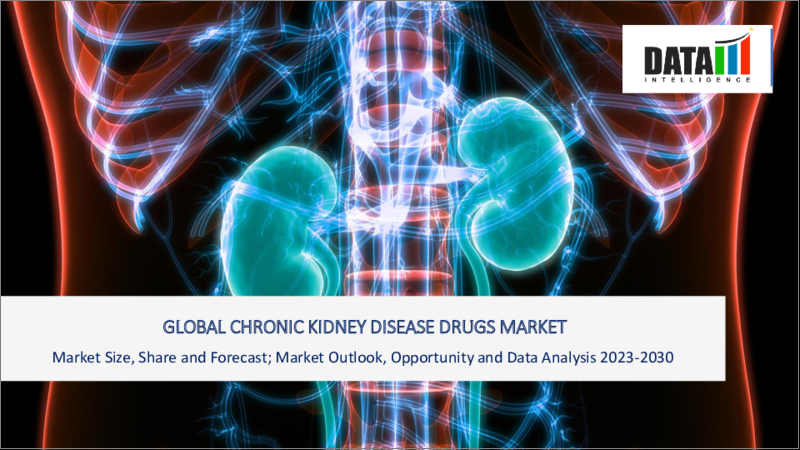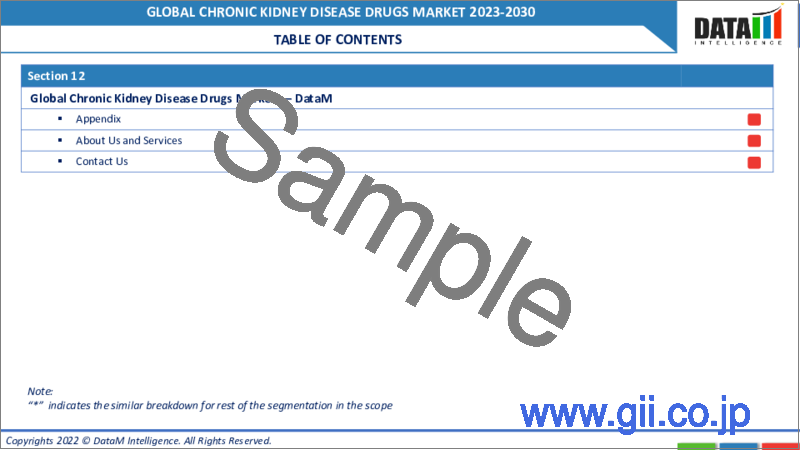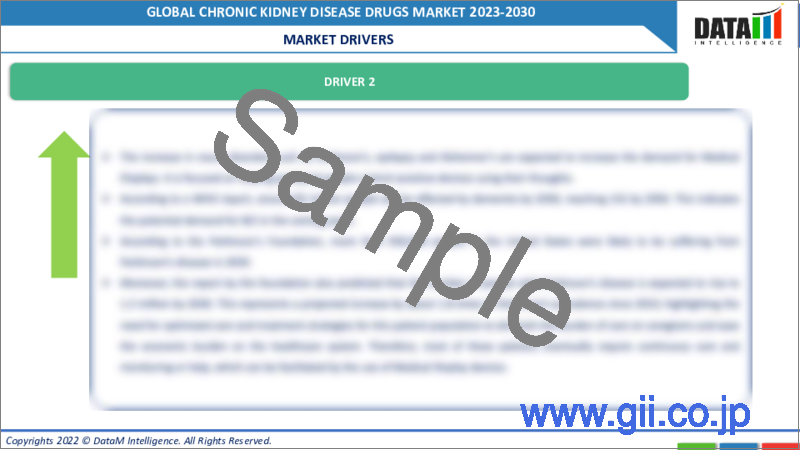|
|
市場調査レポート
商品コード
1136901
慢性腎臓病治療薬の世界市場-2022-2029Global Chronic Kidney Disease Drugs Market - 2022-2029 |
||||||
|
● お客様のご希望に応じて、既存データの加工や未掲載情報(例:国別セグメント)の追加などの対応が可能です。 詳細はお問い合わせください。 |
|||||||
| 慢性腎臓病治療薬の世界市場-2022-2029 |
|
出版日: 2022年10月13日
発行: DataM Intelligence
ページ情報: 英文 200 Pages
納期: 約2営業日
|
- 全表示
- 概要
- 目次
市場力学
主な原動力は、慢性腎臓病の有病率の増加、容易な入手とともに患者を治療するための薬剤に対する継続的な要求、研究開発の増加、技術の進歩、老年人口の増加が市場成長の原動力になると予想されることです。
慢性腎臓病治療薬に対する要求の高まりが市場成長の原動力になると予想されます。
慢性腎臓病治療薬の世界市場は、主に慢性腎臓病に関連する薬剤の需要が高まっていることが要因となっています。疾病管理予防センターの報告書2021によると、慢性腎臓病の増加はより多くの死亡を引き起こします。それは、十分に認識されていない公衆衛生の危機です。米国では約3,700万人が罹患しており、これは成人人口の15%に相当し、成人の7人に1人以上が罹患していることになります。肥満、高血圧、糖尿病が多いことが慢性腎臓病を引き起こす原因の一つとなっています。そのため、慢性腎臓病の治療薬に対する需要が高まっています。
主要な市場参入企業による技術的進歩の増加が、市場の成長を促進しています。市場では様々な新規研究調査やイノベーションが行われています。例えば、2021年4月、アストラゼネカは、米国食品医薬品局によるFarxiga(ダパグリフロジン)の承認を発表しました。ファルキシガは、推定糸球体濾過量、心血管死、末期腎不全、慢性腎臓病患者に関連するリスクを最小限に抑えるために使用されるナトリウム-グルコース共輸送体2の阻害剤です。
慢性腎臓病治療薬の高コストと副作用が市場成長の妨げとなります。
慢性腎臓病患者の腎機能低下などの合併症を引き起こす慢性腎臓病の成長を最小限に抑えるために様々な薬剤が処方されるため、薬剤関連の合併症などのリスク、高コスト、厳しい規制認可プロセス、曖昧な症状による慢性腎臓病の診断遅延、後発医薬品オプションへの傾斜、薬剤の特許失効が挙げられます。
当レポートでは、世界の慢性腎臓病治療薬市場について、約40以上の市場データ表、45以上の図表、200ページ(概算)にてご紹介しています。
目次
第1章 市場調査手法とスコープ
- 調査手法
- 調査目的および調査範囲
第2章 市場の定義と概要
第3章 エグゼクティブサマリー
第4章 市場の力学
- 市場影響要因
- 促進要因
- 慢性腎臓病治療薬に対する需要の高まり
- 技術的進歩の増加
- 抑制要因
- 慢性腎臓病治療薬のコスト高
- CKD治療薬に伴うリスク
- ビジネスチャンス
- 影響分析
- 促進要因
第5章 産業分析
- ポーターのファイブフォース
- アンメットニーズ
- 疫学
- サプライチェーン分析
- 規制分析
第6章 COVID-19の分析
- COVID-19の市場分析
- COVID-19以前の市場シナリオ
- COVID-19の現在の市場シナリオ
- COVID-19の後、または将来のシナリオ
- COVID-19の中での価格ダイナミクス
- 需要-供給スペクトラム
- パンデミック時の市場に関連する政府の取り組み
- メーカーの戦略的取り組み
- まとめ
第7章 薬剤クラス別
- カルシウム拮抗薬
- ACE阻害剤
- B-ブロッカー
- 利尿剤
- 赤血球造血刺激因子製剤(ESAS)
- その他
第8章 投与経路別
- 経口
- 皮下投与
- 静脈内投与
第9章 流通経路別
- 病院内薬局
- 小売薬局
- オンライン薬局
- その他
第10章 地域別
- 北米
- 米国
- カナダ
- メキシコ
- 欧州
- ドイツ
- 英国
- フランス
- イタリア
- スペイン
- その他欧州
- 南米
- ブラジル
- アルゼンチン
- その他の南米地域
- アジア太平洋地域
- 中国
- インド
- 日本
- オーストラリア
- その他アジア太平洋地域
- 中東・アフリカ地域
第11章 競合情勢
- 主な展開と戦略
- 企業シェア分析
- 製品ベンチマーク
- 注目の主要企業リスト
第12章 企業プロファイル
- Pfizer Inc.
- 企業概要
- 製品ポートフォリオと説明
- 主なハイライト
- 財務概要
- Sanofi S.A.
- F. Hoffmann-La Roche Ltd.
- Teva Pharmaceutical Industries Ltd.
- AstraZeneca Plc.
- Kissei Pharmaceutical Co
- AbbVie Inc.
- GlaxoSmithKline Plc
- Amgen Inc.
- Akebia Therapeutics
第13章 慢性腎臓病治療薬の世界市場-DataM
Market Overview
The Chronic Kidney Disease Drugs Market was valued at US$ 10,923.29 million in 2021 and is estimated to reach US$ 19,427.41 million by 2029, growing at a CAGR of 6.58% during the forecast period (2022-2029).
Chronic kidney disease, also known as chronic kidney failure, describes the gradual loss of kidney function. Kidneys filter the wastes and excess fluids from blood, which are then excreted in the urine.
Market Dynamics
The major driving forces are the increasing prevalence of chronic kidney disease, the continuous requirement for drugs to treat the patients along with easy availability, the increase in research and development, technological advancements and the rising geriatric population are expected to drive market growth.
The rising requirement for chronic kidney disease drugs is expected to drive market growth.
The global market for chronic kidney disease drugs is primarily driven by the rising demand for drugs related to chronic kidney disease. According to the Centre for Disease Control and Prevention report 2021, the increase in chronic kidney disease causes more deaths. It is an under-recognized public health crisis. It affects approximately 37 million people in the U.S., equivalent to 15% of the adult population or more than one in seven adults. The high prevalence of obesity, hypertension and diabetes are some of the reasons that are causing chronic kidney disease. Hence, increasing demand for drugs for the treatment of chronic kidney disease.
Increasing technological advancements by the major key players are driving the market's growth. Various novel research studies and innovations are taking place in the market. For instance, in Apr 2021, AstraZeneca announced the approval of Farxiga (dapagliflozin) by the U.S. Food and Drug Administration. Farxiga is an inhibitor of sodium-glucose cotransporter 2 used to minimize the risk associated with estimated glomerular filtration rate, cardiovascular death, end-stage kidney disease, and chronic kidney disease patients.
Chronic kidney disease drugs' high cost and side effects will hamper the market's growth.
The risks associated with chronic kidney disease drugs such as medication-related complications as a variety of medications are prescribed to minimize the chronic kidney disease growth that leads to some complications such as renal functions degradation of the patient, the high cost, the stringent regulatory approval process, delayed diagnosis of chronic kidney disease due to vague symptoms, the inclination to generic medication options, and the patent expiry of drugs.
Segment Analysis
The calcium channel blockers segment is expected to grow at the fastest CAGR during the forecast period (2022-2029)
The calcium channel blockers segment is the highest market holder in the global chronic kidney disease drugs market. The increased number of chronic kidney diseases leads to the growing demand for treatment drugs and research activities. Calcium channel blockers prevent, treat or improve symptoms in various conditions, such as high blood pressure and coronary artery disease, which can increase the risk of chronic kidney diseases. Presently, dominant calcium channel blockers utilized across the world are phenyl alkyl amines (verapamil), benzothiazepines (diltiazem), and dihydropyridines (nifedipine and amlodipine). A report published in Aug 2022 titled "Renal Function in Hypertensive Patients Receiving Cilnidipine and L-Type Calcium Channel Blockers" reported that around 65-95% of patients with chronic kidney disease are suffering from hypertension. The first line of treatment drugs for hypertension are Calcium channel blockers. These calcium channel blockers act as antihypertensive medicines used widely due to their high tolerability, efficacy in lowering the level of blood pressure, and hypertension-related cardiovascular or renal consequences. For instance, in Aug 2022, AstraZeneca from DELIVER phase III trial released detailed results showing Farxiga reducing cardiovascular death or heart failure.
Geographical Analysis
North America holds the largest market share of the global chronic kidney disease drugs market.
North America dominates the global chronic kidney disease drug market, primarily attributed to the growing prevalence of chronic kidney diseases, kidney failure, and diabetes. The rapid adoption of drugs for CKD is likely to enhance the growth of chronic kidney disease drugs. Furthermore, factors such as the high spending of GDP on healthcare, growing government initiatives, and reimbursement policies in advanced medical treatment options are likely to enhance the growth of the region's chronic kidney disease drugs market.
Moreover, extensive research activities are undertaken by the most prominent players in the area, and the rising demand for technologically advanced treatment will propel the market. Also, key players manufacturing chronic kidney disease treatment drugs are boosting the market. For instance, in Jul 2021, Bayer announced the approval of Kerendia (Finerenone), first non-steroidal, mineralocorticoid receptor antagonist, by the U.S. FDA. Finerenone is used to minimize the risk of decline in estimated glomerular filtration rate, cardiovascular death, end-stage kidney disease and chronic kidney disease patients with type 2 diabetes.
Competitive Landscape
The chronic kidney disease drug market is moderately competitive with local and global companies. Key players contributing to the market's growth are Sanofi S.A., F. Hoffmann-La Roche Ltd., Teva Pharmaceutical Industries Ltd., AstraZeneca Plc., Kissei Pharmaceutical Co, AbbVie Inc., GlaxoSmithKline Plc, Amgen Inc., Akebia Therapeutics and more.
The key players are adopting various growth strategies such as product launches, mergers & acquisitions, partnerships, and collaborations, contributing to the growth of the cardiac ablation devices market. For instance, in Aug 2022, CSL Limited announced the completion of the acquisition of Vifor Pharma AG. CSL got all the necessary regulatory clearances required for Vifor's acquisition.
Pfizer Inc.:
Overview:
Pfizer Inc. is a multinational pharmaceutical company that also works in the biotechnology domain. It was established in 1849 and is headquartered in Manhattan, New York City. It is a manufacturer of various vaccines and medicines for cardiology, oncology, neurology, and immunology.
Product Portfolio:
RETACRIT: Retacrit is a kind of erythropoietin man-made protein made in a laboratory. It is an erythropoiesis-stimulating agent used to treat the anemia caused due to chronic kidney disease.
The global chronic kidney disease drugs market report would provide access to approximately 40+ market data tables, 45+ figures, and 200 (approximate) pages.
Table of Contents
1. Market Methodology and Scope
- 1.1. Research Methodology
- 1.2. Research Objective and Scope of the Report
2. Market Definition and Overview
3. Executive Summary
4. Market Dynamics
- 4.1. Market Impacting Factors
- 4.1.1. Drivers
- 4.1.1.1. The rising requirement for chronic kidney disease drugs
- 4.1.1.2. Increasing technological advancements
- 4.1.2. Restraints:
- 4.1.2.1. High cost of chronic kidney disease drugs
- 4.1.2.2. Risk associated with CKD drugs
- 4.1.3. Opportunity
- 4.1.4. Impact Analysis
- 4.1.1. Drivers
5. Industry Analysis
- 5.1. Porter's Five Forces
- 5.2. Unmet Needs
- 5.3. Epidemiology
- 5.4. Supply chain Analysis
- 5.5. Regulatory Analysis
6. COVID-19 Analysis
- 6.1. Analysis of Covid-19 on the Market
- 6.1.1. Before COVID-19 Market Scenario
- 6.1.2. Present COVID-19 Market Scenario
- 6.1.3. After COVID-19 or Future Scenario
- 6.2. Pricing Dynamics Amid Covid-19
- 6.3. Demand-Supply Spectrum
- 6.4. Government Initiatives Related to the Market During the Pandemic
- 6.5. Manufacturer's Strategic Initiatives
- 6.6. Conclusion
7. By Drug Class
- 7.1. Introduction
- 7.1.1. Market Size Analysis and Y-o-Y Growth Analysis (%), By Drug Class
- 7.1.2. Market Attractiveness Index, By Drug Class
- 7.2. Calcium Channel Blockers*
- 7.2.1. Introduction
- 7.2.2. Market Size Analysis, US$ Million, 2020-2029 and Y-o-Y Growth Analysis (%), 2021-2029
- 7.3. ACE Inhibitors
- 7.4. B- Blockers
- 7.5. Diuretics
- 7.6. Erythropoiesis-Stimulating Agents (ESAS)
- 7.7. Others
8. By Route of Administration
- 8.1. Introduction
- 8.1.1. Market Size Analysis and Y-o-Y Growth Analysis (%), By Route of Administration
- 8.1.2. Market Attractiveness Index, By Route of Administration
- 8.2. Oral*
- 8.2.1. Introduction
- 8.2.2. Market Size Analysis, US$ Million, 2020-2029 and Y-o-Y Growth Analysis (%), 2021-2029
- 8.3. Subcutaneous
- 8.4. Intravenous
9. By Distribution Channel
- 9.1. Introduction
- 9.1.1. Market Size Analysis, US$ Million, 2020-2029 and Y-o-Y Growth Analysis (%), 2021-2029, By Distribution Channel
- 9.1.2. Market Attractiveness Index, By Distribution Channel
- 9.2. Hospital Pharmacies*
- 9.2.1. Introduction
- 9.2.2. Market Size Analysis, US$ Million, 2020-2029 and Y-o-Y Growth Analysis (%), 2021-2029
- 9.3. Retail Pharmacies
- 9.4. Online Pharmacies
- 9.5. Others
10. By Region
- 10.1. Introduction
- 10.1.1. Market Size Analysis, US$ Million, 2020-2029 and Y-o-Y Growth Analysis (%), 2021-2029, By Region
- 10.1.2. Market Attractiveness Index, By Region
- 10.2. North America
- 10.2.1. Introduction
- 10.2.2. Key Region-Specific Dynamics
- 10.2.3. Market Size Analysis and Y-o-Y Growth Analysis (%), By Drug Class
- 10.2.4. Market Size Analysis and Y-o-Y Growth Analysis (%), By Route of Administration
- 10.2.5. Market Size Analysis, and Y-o-Y Growth Analysis (%), Distribution Channel
- 10.2.6. Market Size Analysis and Y-o-Y Growth Analysis (%), By Country
- 10.2.6.1. The U.S.
- 10.2.6.2. Canada
- 10.2.6.3. Mexico
- 10.3. Europe
- 10.3.1. Introduction
- 10.3.2. Key Region-Specific Dynamics
- 10.3.3. Market Size Analysis and Y-o-Y Growth Analysis (%), By Drug Class
- 10.3.4. Market Size Analysis and Y-o-Y Growth Analysis (%), By Route of Administration
- 10.3.5. Market Size Analysis, and Y-o-Y Growth Analysis (%), Distribution Channel
- 10.3.6. Market Size Analysis and Y-o-Y Growth Analysis (%), By Country
- 10.3.6.1. Germany
- 10.3.6.2. The U.K.
- 10.3.6.3. France
- 10.3.6.4. Italy
- 10.3.6.5. Spain
- 10.3.6.6. Rest of Europe
- 10.4. South America
- 10.4.1. Introduction
- 10.4.2. Key Region-Specific Dynamics
- 10.4.3. Market Size Analysis and Y-o-Y Growth Analysis (%), By Drug Class
- 10.4.4. Market Size Analysis and Y-o-Y Growth Analysis (%), By Route of Administration
- 10.4.5. Market Size Analysis, and Y-o-Y Growth Analysis (%), Distribution Channel
- 10.4.6. Market Size Analysis and Y-o-Y Growth Analysis (%), By Country
- 10.4.6.1. Brazil
- 10.4.6.2. Argentina
- 10.4.6.3. Rest of South America
- 10.5. Asia Pacific
- 10.5.1. Introduction
- 10.5.2. Key Region-Specific Dynamics
- 10.5.3. Market Size Analysis and Y-o-Y Growth Analysis (%), By Drug Class
- 10.5.4. Market Size Analysis and Y-o-Y Growth Analysis (%), By Route of Administration
- 10.5.5. Market Size Analysis, and Y-o-Y Growth Analysis (%), Distribution Channel
- 10.5.6. Market Size Analysis and Y-o-Y Growth Analysis (%), By Country
- 10.5.6.1. China
- 10.5.6.2. India
- 10.5.6.3. Japan
- 10.5.6.4. Australia
- 10.5.6.5. Rest of Asia Pacific
- 10.6. Middle East and Africa
- 10.6.1. Introduction
- 10.6.2. Key Region-Specific Dynamics
- 10.6.3. Market Size Analysis and Y-o-Y Growth Analysis (%), By Drug Class
- 10.6.4. Market Size Analysis and Y-o-Y Growth Analysis (%), By Route of Administration
- 10.6.5. Market Size Analysis, and Y-o-Y Growth Analysis (%), Distribution Channel
- 10.6.6. Market Size Analysis and Y-o-Y Growth Analysis (%), By Country
11. Competitive Landscape
- 11.1. Key Developments and Strategies
- 11.2. Company Share Analysis
- 11.3. Product Benchmarking
- 11.4. List of Key Companies to Watch
12. Company Profiles
- 12.1. Pfizer Inc.
- 12.1.1. Company Overview
- 12.1.2. Product Portfolio and Description
- 12.1.3. Key Highlights
- 12.1.4. Financial Overview
- 12.2. Sanofi S.A.
- 12.3. F. Hoffmann-La Roche Ltd.
- 12.4. Teva Pharmaceutical Industries Ltd.
- 12.5. AstraZeneca Plc.
- 12.6. Kissei Pharmaceutical Co
- 12.7. AbbVie Inc.
- 12.8. GlaxoSmithKline Plc
- 12.9. Amgen Inc.
- 12.10. Akebia Therapeutics
LIST NOT EXHAUSTIVE
13. Global Chronic Kidney Disease Drugs Market- DataM
- 13.1. Appendix
- 13.2. About Us and Services
- 13.3. Contact Us




